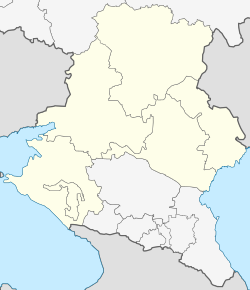This article needs additional citations for verification. (February 2007) |
Lesser Abkhazia (Georgian: ჯიქეთი, Jiqeti) was the term used to refer to those lands of Abkhazia that were not subject to the direct control of the ruling Shervashidze dynasty. The area was part of the Black Sea Governorate during Russian rule.
Lesser Abkhazia
ჯიქეთი | |
|---|---|
 Djiketi and Apkhazeti, 1766 map. | |
| Coordinates: 43°35′N 39°43′E / 43.583°N 39.717°EAn approximate geographical area. | |
| Country | |
| Federal subject | Krasnodar Krai |
History
editThe territory was part of the Kingdom of Georgia between 10th and 15th centuries.
After the Russian-Circassian War, the bulk of the mountaineers relocated to the Ottoman Empire, while the depopulated coastline was gradually colonized by Christian settlers of various ethnicity.
Sadzen was an ill-defined region on the eastern shore of the Black Sea which used to be settled by the Sadz people, hence the name. In the mid-19th century, it came to be known in Russian and Western literature as Lesser Abkhazia. According to Ivane Javakhishvili it is a historical part of Georgia.[1]
The northern part of Sadzen today forms part of Greater Sochi, while the southern part falls within the borders of Abkhazia.[2] The Sochi conflict took place in Sadzen in 1918-1920.
See also
editReferences
edit- ^ Ivane Javakhishvili, Javakhishvili, Ivane (1919). Borders of Georgia.
- ^ The political status of Abkhazia is disputed. Having unilaterally declared independence from Georgia in 1992, Abkhazia is formally recognised as an independent state by 5 UN member states (two other states previously recognised it but then withdrew their recognition), while the remainder of the international community recognizes it as de jure Georgian territory. Georgia continues to claim the area as its own territory, designating it as Russian-occupied territory.

